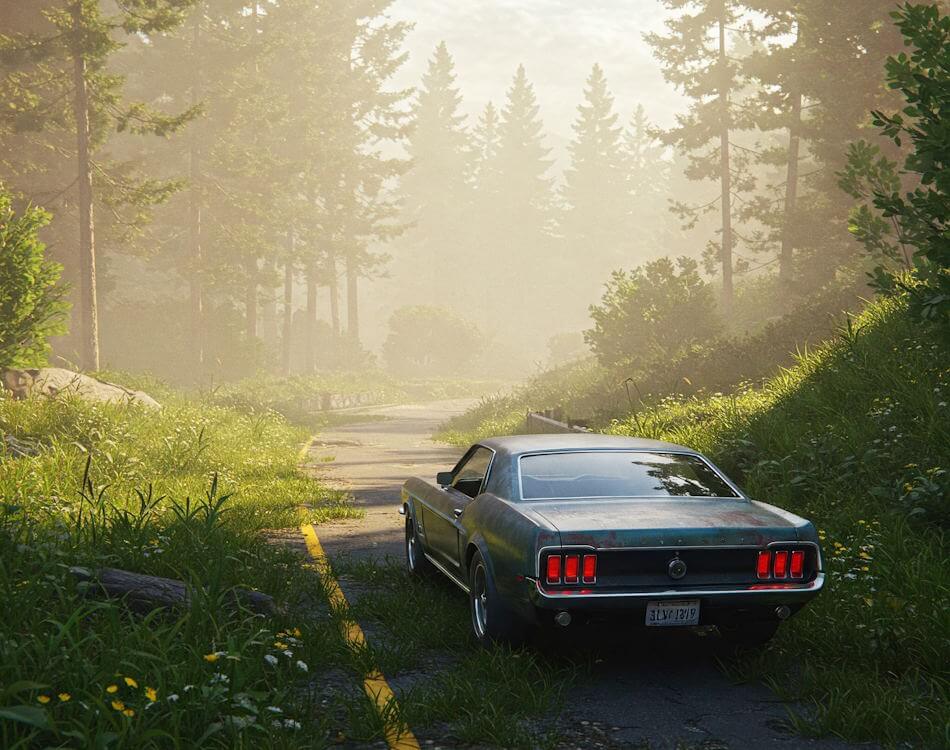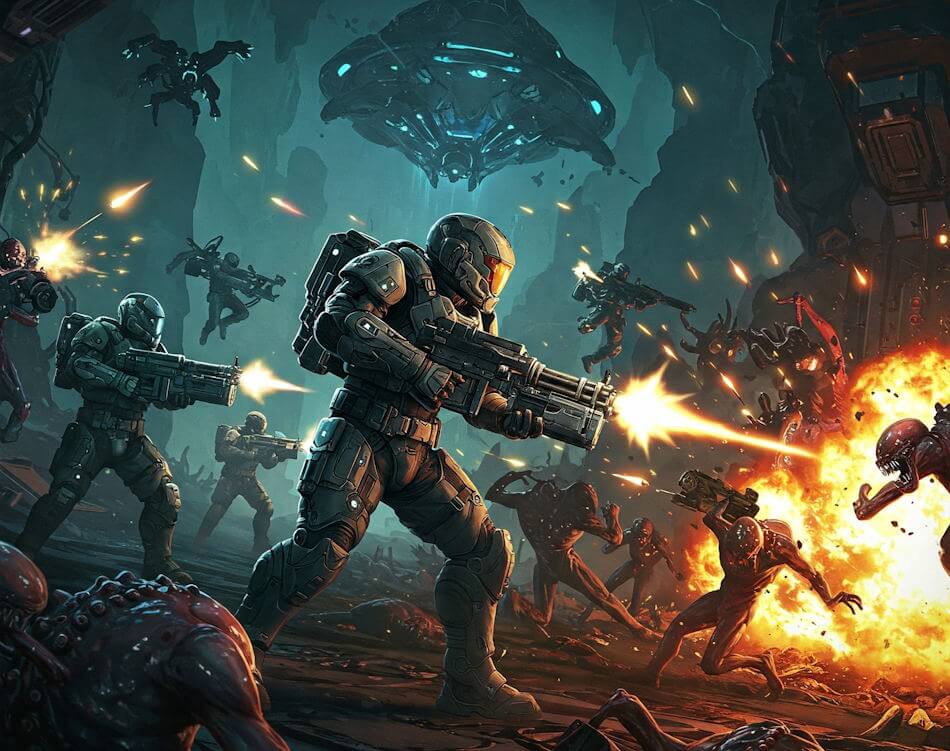Pacific Drive is a groundbreaking survival driving game that transports players into a post-apocalyptic landscape, where the driving experience is intricately tied to exploration and resource management. Players are tasked with navigating a vast, open world filled with both opportunities and dangers, where survival hinges on gathering resources and upgrading their customizable vehicles. The immersive environment not only challenges players to manage fuel, food, and other essential supplies but also encourages them to adapt their strategies as they traverse diverse terrains.
Unlike traditional survival games that often focus solely on character gameplay, Pacific Drive uniquely blends vehicular mechanics with survival elements. As players venture through this desolate yet intriguing world, they must ensure their vehicle is equipped and maintained to withstand harsh conditions and the threats of the environment. Each journey into the strikingly realized landscape presents new challenges, pushing players to make strategic decisions on the fly. This fusion of driving and survival sets Pacific Drive apart from other games in the genre, creating a distinct gameplay experience that prioritizes the vehicle as the central element of survival.
Gameplay Mechanics
Pacific Drive introduces players to an engaging fusion of driving simulation and survival mechanics, set against a backdrop of an expansive open world. At its core, players assume the role of a driver, navigating a variety of terrains while ensuring the survival of both themselves and their vehicle. The gameplay is centered around the unique experience of managing a vehicle in a post-apocalyptic environment, where every journey is fraught with challenges.
The driving mechanics in Pacific Drive are designed to be immersive, allowing players to feel the weight and responsiveness of their vehicle as they traverse through different landscapes. The need for careful navigation is integral, as players must contend with obstacles such as rugged terrain and environmental hazards. The game’s open world is rich with exploration opportunities, encouraging players to discover new locations and gather essential resources that will aid in their survival efforts.
Resource management is a pivotal aspect of the gameplay, requiring players to gather supplies strategically. Resources such as fuel, food, and repair parts must be collected while exploring the environment. Players face the perpetual dilemma of balancing the necessity to forage with the risk of encountering hostile creatures and environmental dangers. This intertwining of survival elements with driving simulation creates a tense atmosphere where every decision impacts the outcome of the game.
In addition to gathering materials for sustenance and vehicle maintenance, players must also address vehicle repairs to ensure optimal performance. The experience is further enriched by the challenges presented by the environment, where players must adapt to changing conditions and unforeseen threats. These core gameplay mechanics work cohesively to heighten the overall gaming experience in Pacific Drive, making it a compelling choice for fans of both driving simulations and survival genres.
Open World Exploration
The world of Pacific Drive offers players an expansive and immersive environment that is ripe for exploration. Set against a backdrop of both breathtaking beauty and desolation, the game features a variety of landscapes, including lush forests, rugged mountains, and stark wastelands. Each of these settings not only provides a unique aesthetic experience but also significantly influences gameplay mechanics. Players will find that navigating through dense foliage can offer natural cover, while open areas may pose risks from external threats, requiring strategic driving and planning.
As players traverse this diverse open world, they are encouraged to embrace a spirit of discovery. Scattered throughout the environment are various points of interest that can deepen the overall narrative of Pacific Drive. Among these locations are abandoned structures, remnants of a civilization once thriving, and otherworldly phenomena that hint at the backstory of this intriguing world. Engaging with these elements allows players to piece together fragments of lore, unveiling narratives that speak to the challenges and history of survival within the game. This emphasis on exploration and storytelling enhances the player’s connection to the environment, making every journey feel consequential.
The design of Pacific Drive’s open world invites players to interact with the surroundings in meaningful ways. As they uncover hidden resources, encounter new challenges, and make choices that affect their survival, the landscapes become an integral part of their experience. The varying climates and terrains not only affect the vehicle’s performance but also contribute to the overall atmosphere. This sense of discovery and the richness of the environments fundamentally shape how players engage with the game, making open world exploration a core facet of Pacific Drive’s appeal.
Customization and Upgrades
In Pacific Drive, the vehicle serves as the player’s primary lifeline, making customization and upgrades a vital part of both gameplay and survival strategy. Players are presented with various options to enhance their vehicles, tailoring them to suit individual play styles and overcoming the diverse challenges encountered in the wild. The customization system allows players to modify aspects such as speed, durability, and inventory capacity, each presenting unique benefits that can significantly affect gameplay.
Speed upgrades, for instance, can be critical for escaping from dangerous situations or quickly traversing hazardous terrains. Enhancements to durability can ensure that the vehicle withstands environmental pressures and potential attacks from wild creatures. Furthermore, increasing inventory capacity is essential for players looking to gather resources effectively without needing to make frequent trips back to base. Each upgrade plays a strategic role, compelling players to think critically about which modifications will offer the most advantage based on their current circumstances.
The variety of upgrades available is not limited to mere mechanical improvements. Players can opt for aesthetic customizations that allow for a personalized vehicle design, enhancing the overall immersion of the experience. This element of design creates a deeper connection between the player and their vehicle, transforming it from a simple mode of transport into a personalized extension of their survival strategy.
Moreover, the upgrade system encourages players to engage in resource management and exploration, as collecting the necessary materials for enhancements often drives them to venture into uncharted territories. By understanding the potential of each upgrade, players can effectively strategize their choices, ensuring their vehicle remains robust, adaptable, and ideally suited to tackle the challenges of Pacific Drive’s unpredictable environment.
Survival Elements
In Pacific Drive, survival intricately weaves into the core gameplay mechanics, compelling players to strategize and manage limited resources effectively. A central aspect of survival focuses on the player’s vehicle, which serves not only as a mode of transportation but as a lifeline in the game’s unforgiving environments. Monitoring the vehicle’s fuel levels is crucial; players must frequently scavenge for fuel supplies to maintain mobility. Insufficient fuel can result in being stranded in dangerous territories, intensifying the sense of urgency that characterizes the game.
Alongside fuel, players must also pay attention to the vehicle’s health. Damage can accumulate due to the hostile conditions present within the game world, which introduces a need for repairs. Players will encounter an array of environmental hazards including toxic landscapes, treacherous weather conditions, and deteriorating roads, each contributing to the potential degradation of their vehicle. Thus, scavenging for repair kits and parts becomes vital to ensure they remain operational and capable of performing evasive maneuvers when threatened.
Moreover, resources extend beyond the vehicle to include supplies necessary for survival. Players must forage for food, water, and other essential materials while navigating through perilous locations. The constant threat from hostile entities adds another layer of complexity to these survival mechanics. These entities, often erratic in their behavior and driven by their own narratives, can attack unexpectedly, disrupting progress and forcing players to abandon critical tasks.
Overall, the survival mechanics in Pacific Drive create a tense and engaging environment, where every decision impacts the player’s journey. The interplay between managing fuel, vehicle health, and supplies against the backdrop of various threats establishes a rich and immersive survival experience that keeps players on their toes.
Art Style and Sound Design
The art style of Pacific Drive showcases a unique blend of realism and stylization that effectively captures the essence of a post-apocalyptic landscape. The environments are meticulously crafted, featuring a mix of desolate forests, abandoned highways, and remnants of civilization. This attention to detail evokes a sense of loneliness and trepidation, which is essential for immersing players in the survival gameplay. The use of a vibrant yet subdued color palette further enhances the overall atmosphere, allowing players to feel the weight of their surroundings while still being drawn into the vibrant hues that punctuate the environments.
Character design also plays a pivotal role in the visual narrative of Pacific Drive. The protagonists are designed with a sense of realism, which not only makes them relatable but also reflects the harsh realities of their circumstances. The ability to customize the character and vehicle adds an additional layer of engagement, allowing players to express their personal style while navigating through a hostile world. Each design choice contributes to the feeling of survival, as players must adapt and improvise in a constantly changing environment.
Sound design is equally important in crafting the immersive experience that Pacific Drive offers. Ambient sounds, such as rustling leaves and distant thunder, create a dynamic auditory landscape that complements the visual aesthetics. The sound of the vehicle, including its engine roar and tires crunching over various surfaces, accentuates the perilous journey players embark on. Additionally, the music seamlessly weaves into the gameplay, heightening emotional moments and enhancing the tension during critical encounters. By intricately interlinking soundscapes with visual elements, Pacific Drive cultivates an engaging and deeply atmospheric experience, drawing players deeper into its world where every decision influences their survival.
Community and Multiplayer Features
In the ever-evolving landscape of gaming, community engagement is a crucial factor that shapes player experiences and enhances the overall enjoyment of a title. In the case of Pacific Drive, the community and multiplayer features play a significant role in fostering collaboration and interaction among players. With a strong emphasis on survival, the game encourages players to share strategies, resources, and experiences, thereby enriching their gameplay.
One of the standout aspects of Pacific Drive is its cooperative multiplayer mode, which allows players to team up for survival missions. This cooperative play not only provides an avenue for players to strategize together but also enables them to tackle challenges that may be insurmountable when approached solo. By working in tandem, players can share their vehicles, repair resources, and jointly navigate the treacherous landscapes, thereby promoting a sense of camaraderie and teamwork.
Moreover, the game has integrated platforms for players to communicate and exchange ideas. Various online forums and social media groups have emerged, where players share their unique experiences within the game, discuss tactics for effective survival, and offer tips on optimizing vehicle performance. Such platforms create a vibrant ecosystem where feedback is readily exchanged, leading to a more informed player base.
Player feedback is instrumental in the development process of Pacific Drive. The developers actively seek input from the community regarding gameplay mechanics, desired features, and potential improvements. This open dialogue not only demonstrates the developers’ commitment to enhancing the player experience but also empowers players by making them a vital part of the game’s evolution. By incorporating community insights into updates and expansions, Pacific Drive continues to thrive as a dynamic and engaging survival experience.
Comparative Analysis with Similar Games
Pacific Drive has emerged as a unique entry in the survival gaming genre, setting itself apart through its distinct blend of vehicular mechanics and atmospheric storytelling. Unlike traditional survival games that typically emphasize resource management and crafting systems, Pacific Drive engages players by placing them behind the wheel, seamlessly integrating driving into the survival experience. This approach evokes a sense of mobility and urgency, presenting players with the challenge of navigating a treacherous landscape while managing both the environment and their vehicle’s condition.
One notable comparison can be made with titles like DayZ and The Long Dark. While these games focus heavily on exploration and character health management, Pacific Drive shifts the perspective to that of the vehicle itself, creating a compelling dynamic. Players must not only prioritize their character’s survival but also the durability and functionality of their vehicle—a critical aspect that lends itself to heightened tension and immersion. The game’s environment is replete with hazards that can affect automobile performance, challenging users to make strategic decisions on the fly.
Additionally, the narrative layer in Pacific Drive distinguishes it from its peers. While many survival games offer a relatively loose framework or focus primarily on player-versus-player interactions, Pacific Drive intertwines storytelling elements deeply within the gameplay. The world is infused with lore, providing context and emotional resonance to the challenges players face. This dedication to narrative parallels the ambiance found in Firewatch and Oxenfree, which are celebrated for their storytelling yet maintain their own distinct gameplay mechanics.
In conclusion, Pacific Drive stands apart from other survival games by offering a driving-centric experience enriched with storytelling and atmospheric exploration. The game captures the essence of survival through innovative mechanics and an engaging narrative, ultimately carving its niche in a crowded genre.
Final Thoughts and Recommendations
Pacific Drive stands out in the survival game genre by crafting an experience that is both engaging and innovative. It combines elements of exploration, resource management, and vehicle-based survival, delivering a unique approach that keeps players invested. The game offers a rich atmosphere, set against a backdrop of eerie landscapes and environmental challenges. This thematic choice enhances immersion, allowing players to genuinely feel the tension that accompanies survival in this mysterious world.
One of the strengths of Pacific Drive is its distinctive gameplay mechanic that centers around vehicle management. Players are not only tasked with surviving but also with developing and upgrading their vehicle, which becomes an extension of themselves throughout the game. This focus on vehicular survival adds an interesting layer, requiring players to think critically about their resources and to carefully plan their routes. Additionally, the crafting system allows for a strategic approach to survival, granting players the tools necessary to adapt to the unpredictable world they navigate.
However, the game is not without its weaknesses. Some players may find the learning curve steep, especially if they are unfamiliar with survival mechanics or resource management within a gaming context. Additionally, certain gameplay elements, such as the pacing and encounter frequency, may vary widely, leading to an occasionally inconsistent experience. Despite these issues, the overall premise of Pacific Drive is compelling, and its strengths often overshadow its shortcomings.
For potential players, Pacific Drive will likely appeal to those who enjoy immersive survival experiences with a focus on exploration and strategy. It is highly recommended for fans of non-traditional survival games who are looking for a new twist on the genre. Ultimately, for players seeking an experience that prioritizes atmospheric storytelling and hands-on vehicle management, Pacific Drive may very well be worth the journey.



